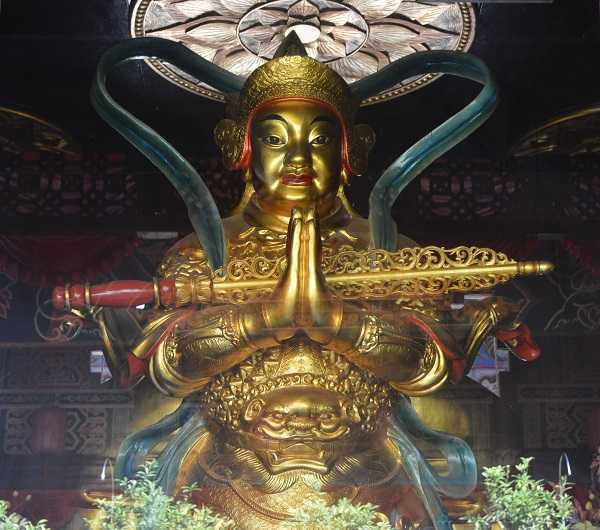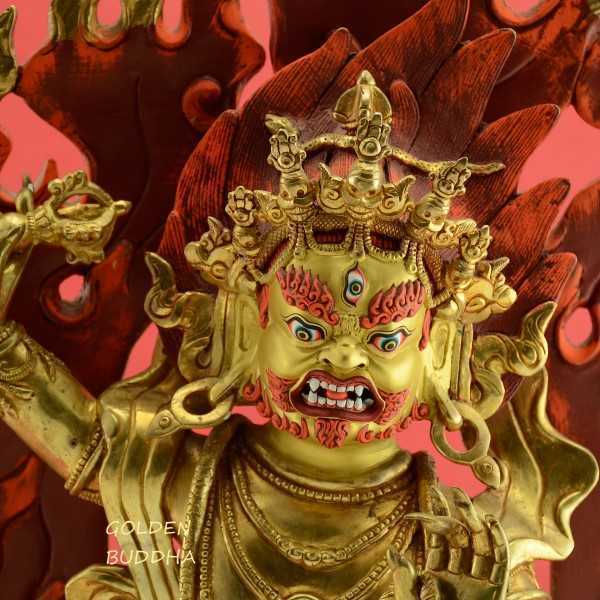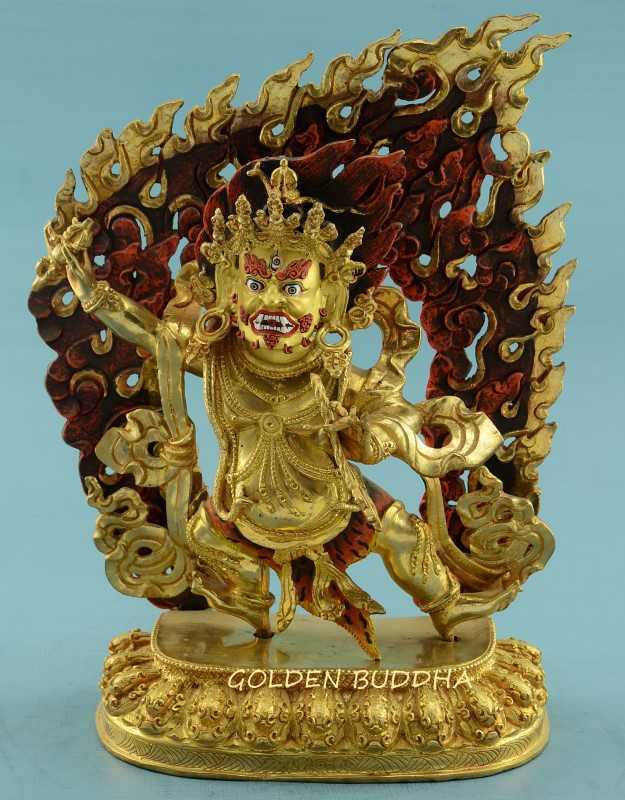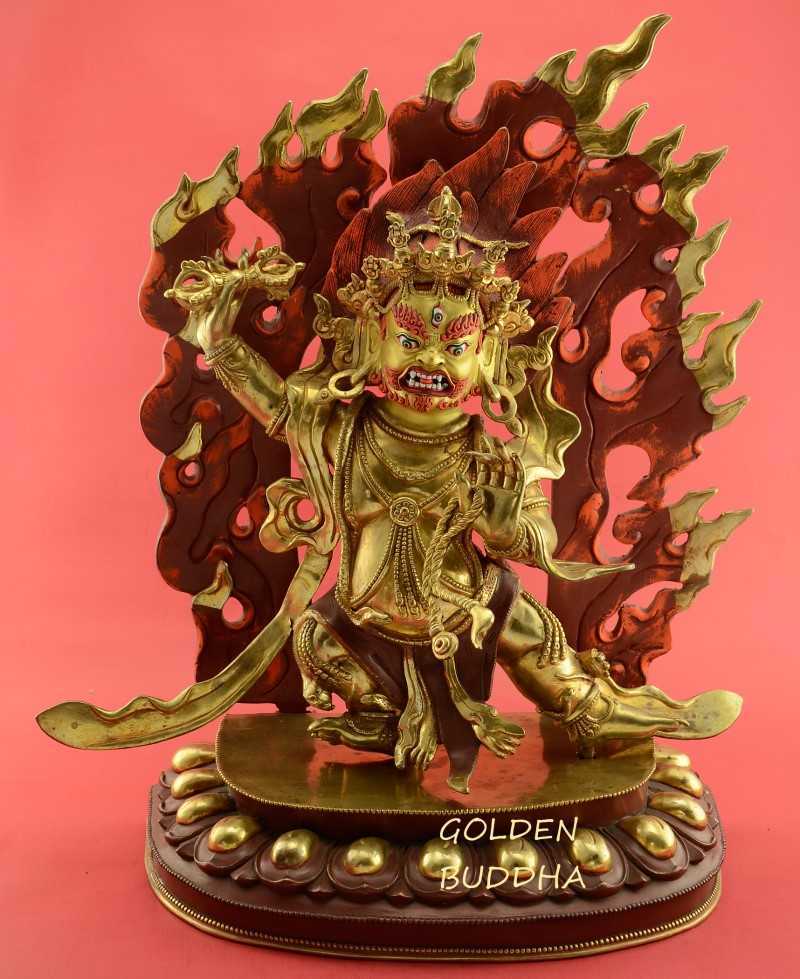The inspiration of Vajrapani statues originates in the Mahayana Buddhist sutras as a “yaksha”. Indeed, the existence of yakshas predates the inception of Buddhism by a large margin. However, new religions throughout history have sometimes adopted powerful deities already established in local beliefs. As a result, the yaksha’s powers helped Mahayana Buddhism to gain acceptance.
In Pre-Buddhist beliefs, the yakshas were forest deities who were defenders of buried treasure. However, they could be mischievous and even deadly if provoked. Additionally, they had magic powers combined with the ability to change their physical form. Therefore, the depictions of yakshas in ancient India would serve as prototypes for Hindu, Jain and Buddhist deities.
The Introduction of Vajrapani
In Buddhism, Vajrapani statues have evolved as peaceful, semi-wrathful or wrathful depending on which Buddhist school oversaw its creation. Vajrapani has indeed developed into one of the most unique aspects of Buddhist art.
Vajrapani’s initial appearance occurs in the Ambattha Sutra when he appears during a conversation the Buddha is having with the youth – Ambattha. The Buddha has asked a pressing question to Ambattha about his family’s origin which Ambattha is reluctant to answer.
However, the Buddha is very persistent and says – “Answer me now, Ambattha, this is not the time for silence. Whoever, Ambattha, does not answer a fundamental question put to him by a Tathágata by the third asking has his head split into seven pieces.”
As a result, “Vajrapani the yaksha” appears holding a “huge iron club, flaming, ablaze and glowing” up in the sky over Ambattha. Therefore, Ambattha becomes visibly shaken and asks the Buddha to repeat the question – after which he promptly and truthfully answers the Buddha – Vajrapani then vanishes from the sutra text.
Peaceful Vajrapani Statues
The description of Vajrapani in the Ambattha Sutra is indeed threatening. However, Vajrapani statues based on the Mahayana sutras are peaceful in nature and depict normal human features. Additionally, in Mahayana beliefs, Vajrapani is a Bodhisattva who embodies the Buddha’s power and acts as his guide and protector. He is also strongly affiliated with Avalokiteshvara (Buddha’s compassion) and Manjushri (Buddha’s wisdom).

Wrathful Vajrapani Statues
Several centuries later, the more progressive Vajrayana Buddhism would introduce wrathful Vajrapani as Guhyapati – “The Lord of Secrets”. This is because he is the receiver of the Tantric texts from Vajradhara Buddha and charged with their protection and preservation. Additionally, his spiritual mandate would further evolve as the Tantric teachings were adopted in Tibet.
This new appearance of Vajrapani was wrathful with strong similarities to the flesh eating Raksha demon of Hindu mythology. Indeed, the Rakshas are so voracious they tried to consume the Hindu god of creation – Brahma. However, they were unsuccessful after Lord Vishnu came to the rescue.
As a result, wrathful Vajrapani statues have a gruesome appearance meant to inspire devotees and loosen the grasp of ignorance, desire and hatred. Therefore, Vajrapani stands within a the flames of awareness and he has three glaring eyes representing his knowledge of the past, present and future. Additionally, he is adorned with serpents and stands in warrior pose with a vajra held high in his right hand and a demon lasso in his left hand.
Wrathful Vajrapani Statue
The Wisdom of Vajrapani Statues
The frightful adornments of Vajrapani statues are similar to other Tantric deities. However, the objective is to create positivity not negativity. Indeed, the five skulls on his crown have a special symbolic meaning. The five skulls represent the death of negativity and the creation of sublime qualities.
- Ignorance → Wisdom of Reality.
- Pride → Wisdom of Equality.
- Attachment → Wisdom of Discernment.
- Jealousy → Wisdom of Accomplishment.
- Anger → Wisdom of Equanimity.

The Expediency of Vajrapani Practice
Vajrapani practice is based on the Tantric path. Indeed, the Tantric path to enlightenment offers an expedient alternative to traditional practice. During Vajrapani practice, Tantric practitioners envision themselves as Vajrapani during meditation and can transform themselves into the deity using this method.
However, the Tantric teachings are only held by a few and are not made public. As a result, the practitioner must be under the guidance of a qualified teacher. If so, it is apparently possible to accomplish enlightenment in a single lifetime.
Vajrapani Mantra:
“Om Vajrapani Hum”



